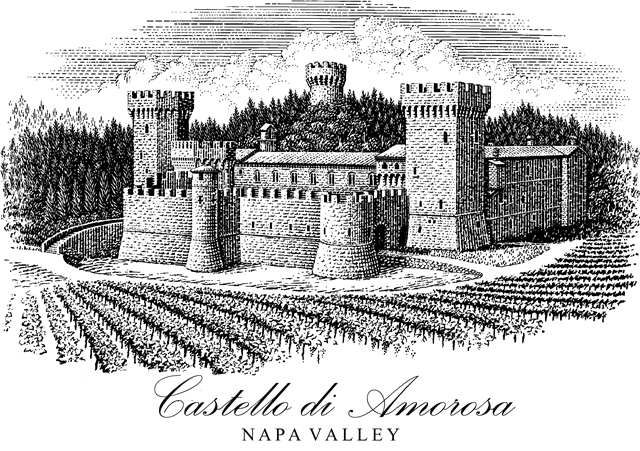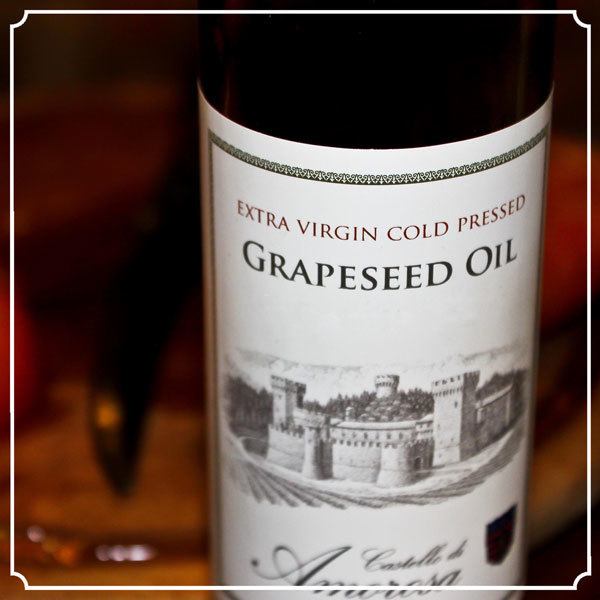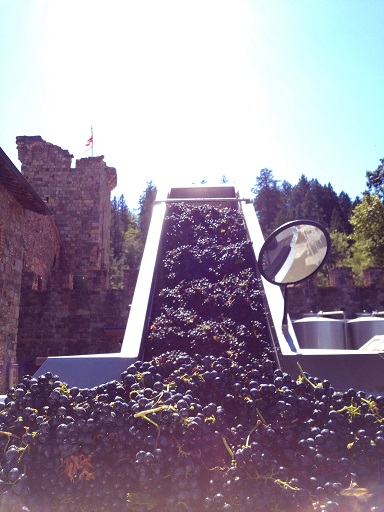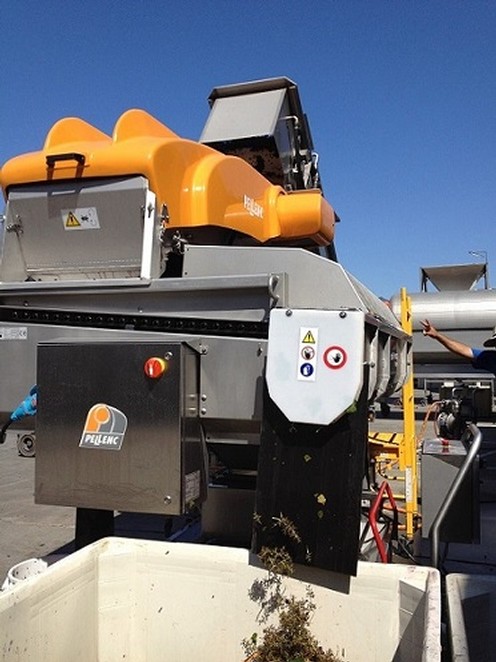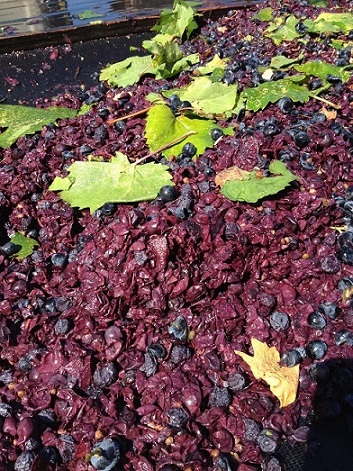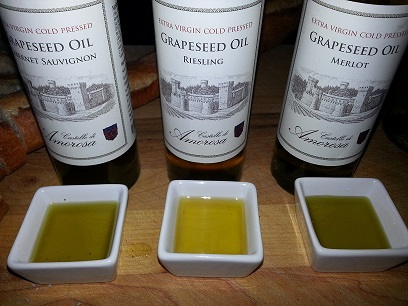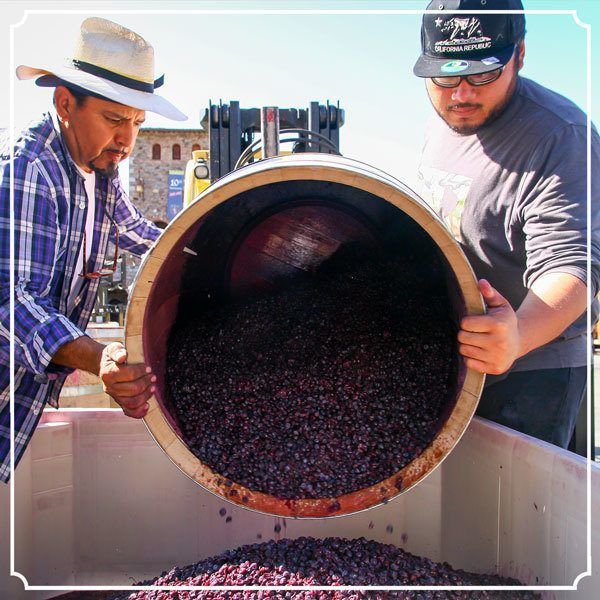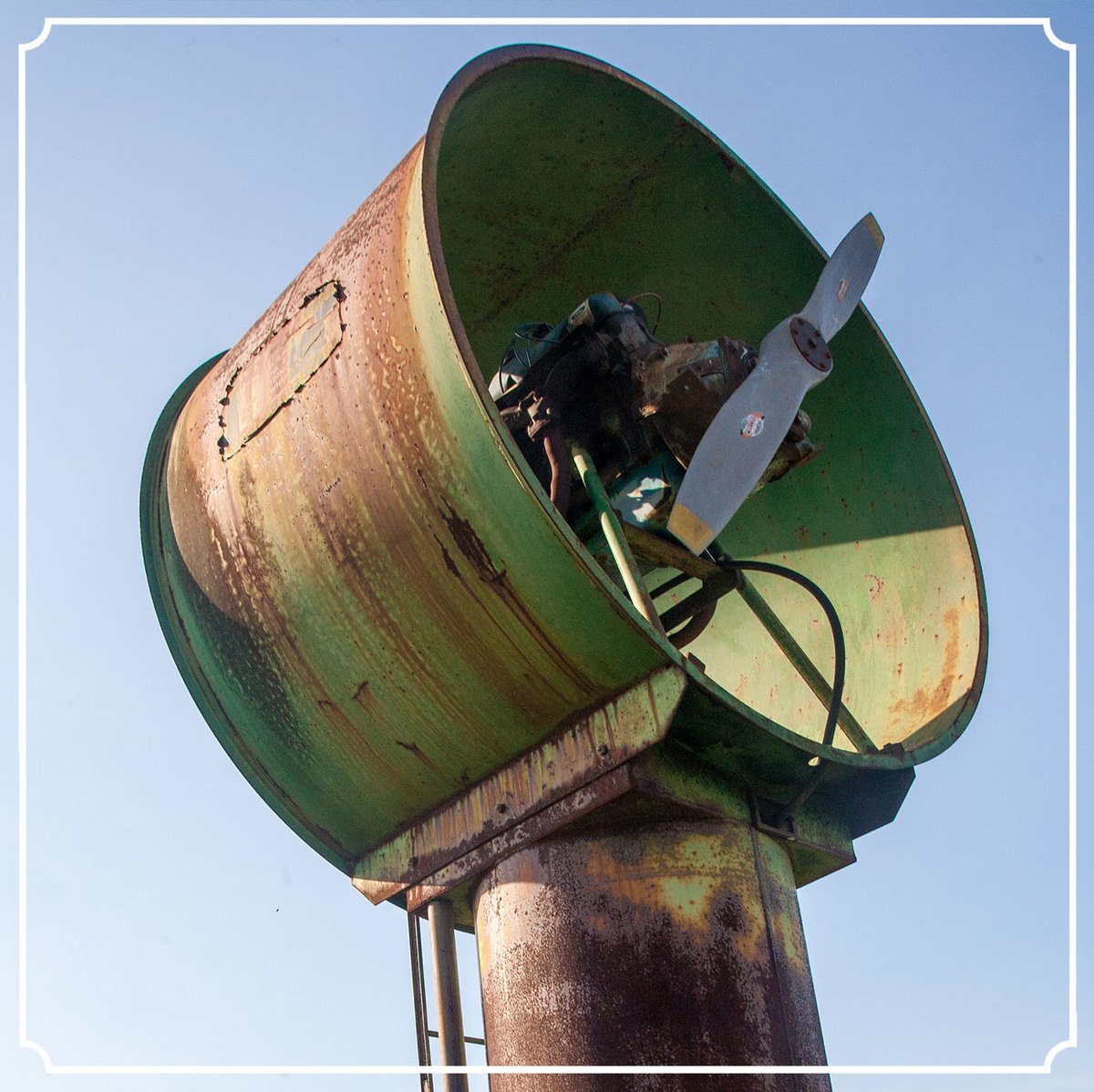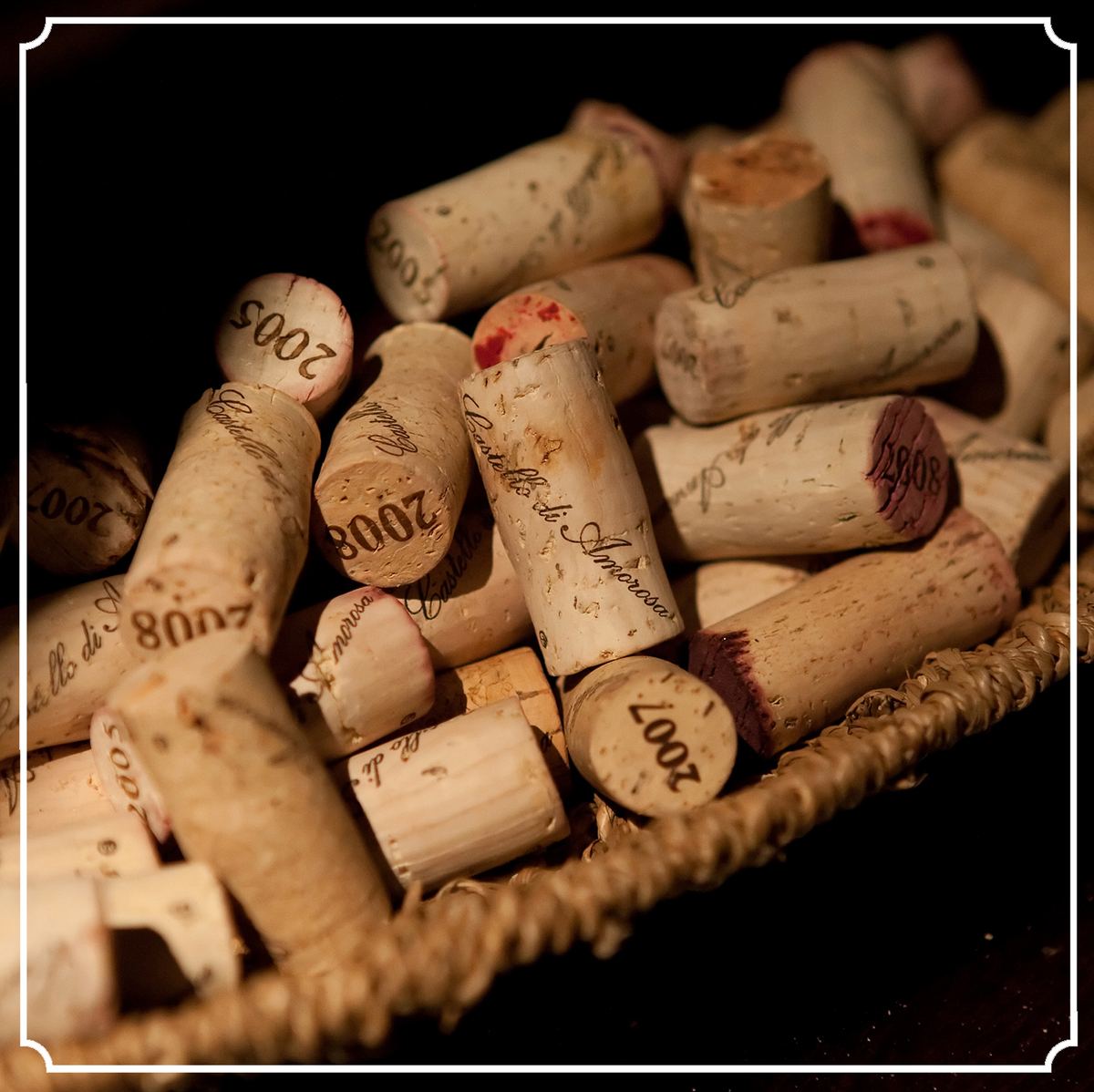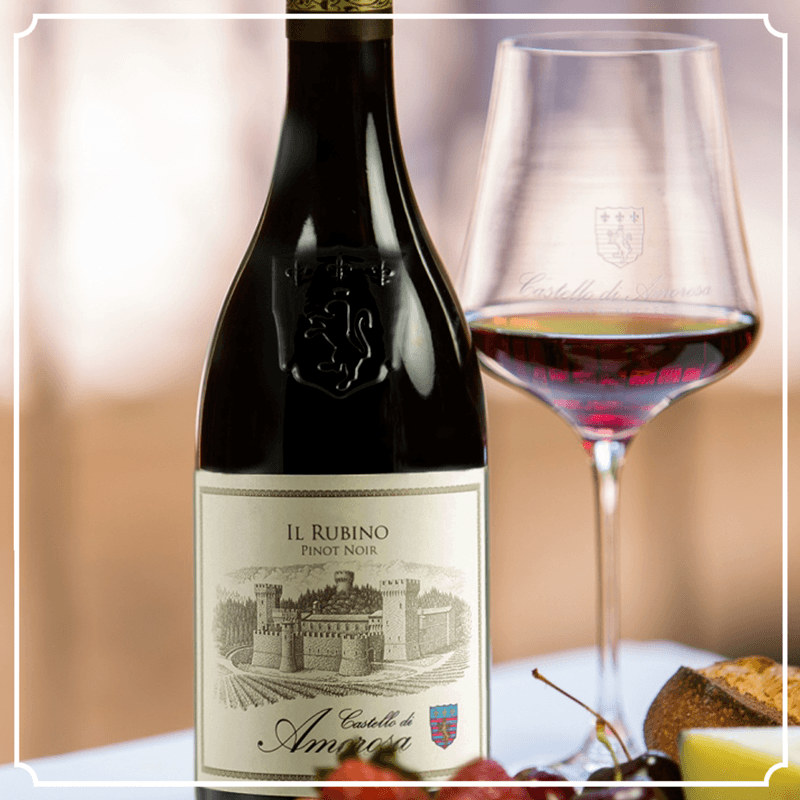Silence of the Lamb Shanks

Mary Davidek
Silence of the lams shanks
In all honesty, Halloween has never been my favorite holiday. I don’t have a sweet tooth, I never liked to dress in costumes and fright movies terrify me. With three older brothers I was often the victim of pranks and shenanigans and I am quite certain my irrational fear of monkeys and primates can be traced to the mischief my brothers concocted which turned grade school trips to the zoo into angst ridden rituals. The only aspect of Halloween I truly warmed to was the fact that traditionally Halloween marks the beginning of the holiday season. Fall and winter vegetables replace summer fruits and the conspicuous cornucopia of harvest prevails. Bring out the blankets and smell the spices wafting in the chilled autumn air.
I know, I know… it’s Halloween and fright-night festivities may be on the agenda; perhaps not a trick-or-treat outing but maybe a cozy dinner party with a few friends followed by a few favorite movies. And just because it’s a holiday spotlighting pumpkins and candy corn does not mean we should throw thoughts of food and wine pairing to the jack-o-lantern! Take a cue from one of the most ominous and frightening movie monsters in history, move over Freddy and Jason—Hannibal Lecter gets my vote for Halloween’s classic scary movie poster- boy! Hannibal is creepy, petrifying and unnervingly disturbing and yet even while shackled in chains and full facial restraint he maintained a pompous arrogance. This notorious villain has one quality I can’t fault; he certainly cared about pairing his meals with the correct wine! *ahem* Plus, he obviously loves vino Italiano which makes Hannibal Lecter Castello di Amorosa’s gruesomely detestable official “Fright Knight’.
Savor this Halloween with a delicious and super easy comforting classic — replete with fava beans and a nice Chianti…. (Sangiovese, of course!) Pop in a DVD and enjoy…..
Silence of the Lamb Shanks!
♦ Easy Crock Pot Lamb Shanks
Brown Lamb Shanks in grapeseed oil in large pan
Season generously with Salt and Pepper
Place browned shanks into crock pot and top with the following:
- 1/2 C red wine
- 1/2 C beef stock
- 1 can (14 oz) Italian style diced tomatoes
- 1 tsp Italian Seasoning
- 8-10 cloves of diced garlic
- 4 large sliced mushrooms
- 1 TBSP Worcestershire
- 1 sweet onion cut into large slices
Place crock pot on low 6 -8 hours, remove shanks and plate with sauce and vegetables
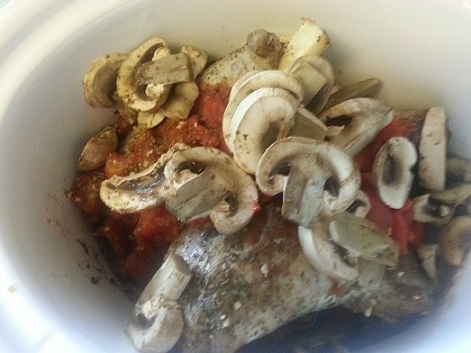
Mushrooms, tomatoes, garlic, broth and red wine create a delicious sauce.

Sangiovese, the primary grape grown in the Chianti region of Tuscany, is a very important varietal at Castello di Amorosa. Sangiovese also provides a spine of bright red cherry in blends like Il Brigante and La Castellana.
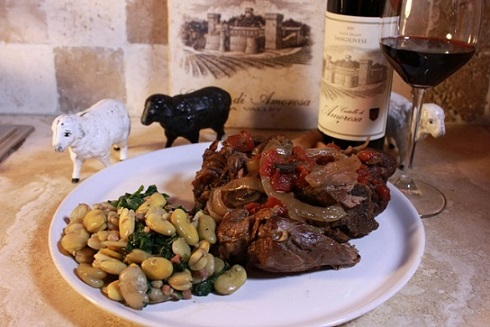
The Silence of the Lamb Shanks, fava beans, and a nice ‘Chianti’ in true Castello style!
Happy Halloween!
Grape Seed Oil- Enlightened

Mary Davidek
Meet Mary
Grape Seed Oil Process – Enlightened
For the last 19 months, I have been on a journey of more healthful eating. This has included only small quantities of lean meats with most animal proteins in the family of fish and fowl. Most of my daily caloric intake comes from fiber via fruit, vegetables, nuts and whole grains. I thought I was doing great; losing pounds, gaining stamina….I felt renewed…invigorated… healthy. However, while a high-fat, high-calorie diet increases the risk of gallstones, apparently a very low fat weight loss plan can also cause issues. While a low fat diet allows you to lose weight, with smaller quantities of fat and oil to break down, the gallbladder does not contract or empty as frequently, and, as a result, this may produce a build-up of bile and possibly an increased risk of gallstones.
With my gallbladder permanently out of the equation, I’ve taken time in the last few weeks for a little research…. along with a little lab work (i.e. cooking in the kitchen) in an effort to repair my relationship with fats and oils.
Oils are fats that are liquid at room temperature. Although oils are not a food group, they provide essential nutrients and are therefore included in USDA recommendations of what to eat. Most fats should be polyunsaturated (PUFA) or monounsaturated (MUFA) fats. Oils are the major source of MUFAs and PUFAs in the diet.
My research eventually took me to an article published by Bon Appétit. Who better than the good eating experts to help guide me in my search for healthy and tasty oil? “Some fat is actually good for you,” the article quotes Alice H. Lichtenstein, director of the cardiovascular nutrition laboratory at Tufts University. “But, to get the most from fats, you need to go beyond olive oil. Open your cupboard to new flavors, cooking temperatures–and health benefits–by diversifying your oils.” In the number one position of most healthful oil on Bon Appétit’s list—grape seed oil! High in polyunsaturated fats and vitamin E, grape seed oil has a high smoke point, which makes it a good substitute for olive or vegetable oils for a sauté or stir-fry, and because it has light and clean flavors on the palate, it lets top-notch ingredients stand out.
I remain diligent when it comes to healthy eating and food choices. However, as a discerning skeptic my cynical tendencies combined with my resistance to change has always played second string to the great equalizer; taste! Donning a lab coat for this foray instead of an apron, I must experiment. I made a few fairly standard favorites where I traditionally used olive oil and substituted grape seed oil.
The results were en-lightening!
The process begins on the conveyor for these yummy clusters. Ready to go into the hopper where the stems will be separated and then composted.
Although we are a world of organic goals, long term sustainability is realistic and achievable now. The stems are separated from the clusters and prepared for composting and provide vital nutrients in the vineyard.
After fermentation and a final press of the skins, the pumace is taken and the seeds will be separated and dried.
. 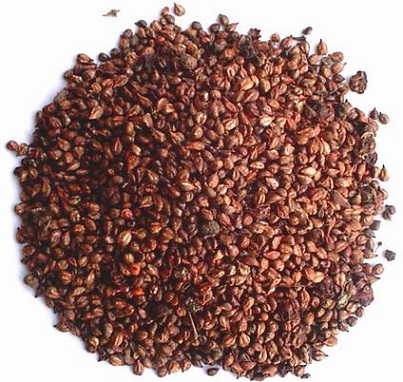
After several months, the dried grape seeds are ready to be pressed and oil is extracted from the seeds. The oil is obtained through pressing and grinding seeds with the use of stainless steel presses. Since grape seeds are discarded as part of the wine making process, the extraction of the oil is an efficient and sustainable use of a byproduct.
The best oils are cold pressed. Although pressing and grinding produces heat through friction, the temperature must not rise above 120°F for any oil to be considered cold pressed. Cold pressed oils retain their flavor, aroma, and nutritional value. Sample cold pressed grape seed oils at Castello di Amorosa on the Royal Food and Wine Pairing tour.
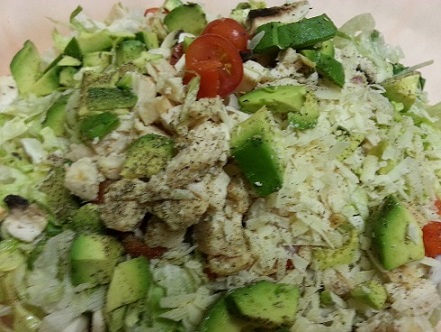
Since grape seed oil is lighter than olive oil, I was having a problem with a pool of oil accumulating at the bottom of the salad bowl. Problem solved; when making salads, I now add the seasonings and toss it which coats the lettuce with the seasoning giving the oil something to adhere to. Light, healthy and the lettuce retained its crispness.
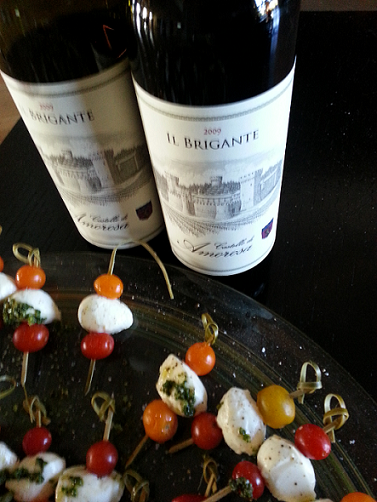
I drizzled a little Sauvignon Blanc grape seed oil and basil on the bruschetta bites—delicious!
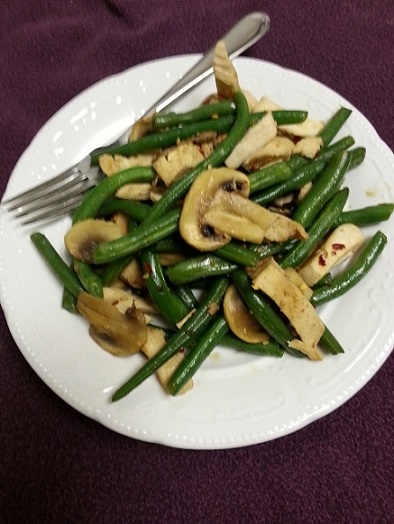
Stir fry and sautés are my favorite use of grape seed oil. Since grape seed oil has a higher smoking point than olive oil, veggies and meat are added to a hotter pan. Plus, the grape seed oil gives off very little flavor in a sauté and this really lets the ingredients shine.
Bring on the Pig-ment-Skin

Mary Davidek
Bring on the Pig-ment-Skin
As summer comes to a close and long hot days become abbreviated and alleviated with cooler temps and sweater worthy evenings–September is here. With it, the beauty of harvest and fall is underway. Undeniably my favorite time of the year; the anticipation, the realization of another season. Nervously…… we wait. The hopes, the expectations— will it be as good as last year? Will this year bring the success of another triumph? Will we get the points and revel in great scores? It has finally arrived.
That’s right… are you ready for some football!?
Regular season NFL starts this week and the pigskin is finally back in action. Of course, while the football is being passed and punted on the gridiron the red zone has officially been crossed at my house. Bring on the pigment!
All wine grapes contain clear juice. Although there are a few varietals with tinted juice it is extremely rare. Red wine becomes colored or pigmented in the winemaking process. The liberated or pressed juice of black grapes are fermented in contact with the skins. Since the skins contain all the color, fermentation with the skins extracts this color to the juice and resultant wine. The skin of black grapes also contains complex elements that not only result in this pigmented juice, but imparts tannins and many healthful antioxidants.
My match-up this week includes Cabernet Sauvignon; and since it doesn’t get much more pigmented than this thick-skinned varietal… well….. this pairing calls for a pepper spiked little pig of my own to mark the occasion.
Cheers, or as they say on the field—get ready for kickoff!
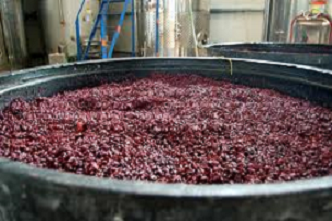
No need for binoculars! View this action live and in person from the proverbial 50 yard line! Fall is the time of year for a trip to wine country. Watch the winemaking process from Castello di Amorosa’s home field, the crush pad!
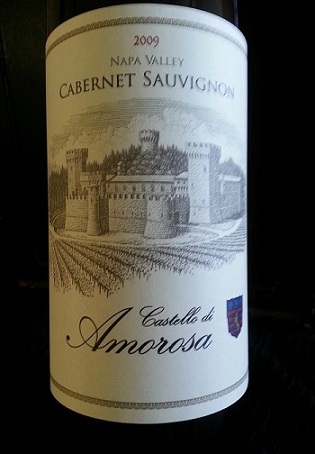
Talk about score! Robert Parker gave Castello di Amorosa’s 2009 Cabernet Sauvignon 91 points! This 100% Cabernet Sauvignon is brawny with loads of muscle yet exhibits a graceful and elegant mouth feel. Brooding deep dark fruit with a hint of spice box and black pepper. Touchdown!
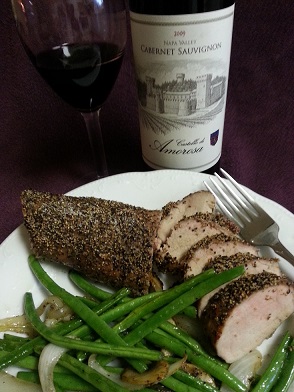
Simple, quick and delicious. This meal won’t keep you away from important plays! I sprinkled the tenderloin with sea salt and garlic powder then very generously coated it with coarse ground pepper. Bake at 350 degrees until the center of the loin reaches 150 deg. Let rest for 10-15 minutes before serving. The peppery seasoned tenderloin plays off the dark fruit of the Cabernet. After Sunday’s match-up this makes for incredible sandwiches to enjoy the next night…during Monday Night Football!
A Chill In The Air

Mary Davidek
A chill in the air
Discover how to keep vineyards warm in the winter with expert insights from Castello di Amorosa. Discover solutions used to protect vineyards from the cold. Although long periods of extreme cold and sub-freezing temperatures can always cause distress in a vineyard; frost is particularly damaging in the early spring. Once bud break occurs, spring frosts can kill the young shoots potentially destroying a crop. If you visit wine country in early spring you may spot a few different methods utilized by vintners in attempts to combat frost damage. Most preventative measures are expensive and vary in effectiveness, but, the financial loss of frost damage is extreme.
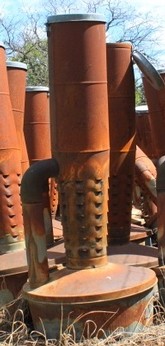
The least utilized and possibly least effective way to keep vineyards warm in the winter is burning oil in a smudge pot. The smoke and heat generated is hopefully carried over the vineyard by the wind forming a warmer protective blanket. As the heavier cold air sinks, the warm blanket of air protects the shoots.
A solution that seems just as drastic but that has actually proven viable in some vineyard locales; spraying the vines with a fine mist of water. As the water freezes it forms a protective layer of ice insulating the young shoots by trapping the heat, (think of an igloo or an ice cave). Since Napa Valley’s Mediterranean climate doesn’t generally dip below 25 degrees Fahrenheit, this method shows promise as it is environmentally less invasive and more economically viable. A negative for using water is fairly obvious but worth noting: you are using water, which can be scarce or completely unavailable in remote vineyards.
The most common and visually the most obvious method in use can be viewed off 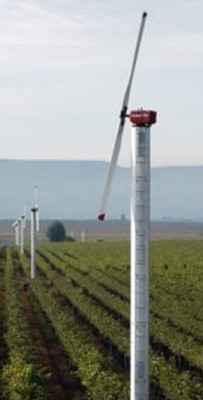 Highway 29 and along the Silverado Trail. What looks like windmills are actually wind machines, which move air over vineyards to keep the coldest air from settling on vulnerable, young shoots. The heavier cold air mixes with the warmer air, being moved by the wind machine, creating a slight elevation in temperature which is often just enough to ward off frost as long as that temperature is above 28 degrees Fahrenheit. However, I live close to one such wind machine and I see it as only partially effective. While it prevents frost from developing in areas directly in the path of said turbulence, my personal observation is the outlying areas are often blanketed with frost. Another fact to consider…..wind machines are essentially propellers that run on fuel so they can be expensive to run and the noise level can be extreme – especially in the wee hours of the morning when they are typically used. *yawn*
Highway 29 and along the Silverado Trail. What looks like windmills are actually wind machines, which move air over vineyards to keep the coldest air from settling on vulnerable, young shoots. The heavier cold air mixes with the warmer air, being moved by the wind machine, creating a slight elevation in temperature which is often just enough to ward off frost as long as that temperature is above 28 degrees Fahrenheit. However, I live close to one such wind machine and I see it as only partially effective. While it prevents frost from developing in areas directly in the path of said turbulence, my personal observation is the outlying areas are often blanketed with frost. Another fact to consider…..wind machines are essentially propellers that run on fuel so they can be expensive to run and the noise level can be extreme – especially in the wee hours of the morning when they are typically used. *yawn*
Does a foolproof solution exist? Well, if you have an opportunity when driving in the valley, look to the hills. It is rare to find any method of frost control on sloped vineyard sites. Dense cold air naturally drains off the hillsides and settles onto the valley floor quite often rendering the hillsides unaffected by frost.
In this north end of the Napa Valley we are fortunate. With the Mayacamas Mountains to the West and the Vaca Mountains to the East, some of the most prestigious viticultural land in the world has been created. Castello di Amorosa’s Il Barone and La Castellana wines are crafted from Cabernet Sauvignon vineyards on Diamond Mountain, part of the famed Mayacamas range; above the fog line, drenched in sunshine and relatively unharmed by frost.
As we continue to progress in viticulture methodology one fact holds true – Mother Nature will always have the final word.
And with that my final word – Cheers!
Mary Davidek C.S., C.S.W.
Corkage Fees and BYOB – Part 2

Mary Davidek
Corkage Fees and BYOB – Part 2
In the last submission I covered the basics of getting your wine to the restaurant. Now, for the dedicated corkage seekers……..let’s continue.
Take care of the waitstaff. Many experienced servers see a bottle carried in and mark you as a diner who is…….well……thrifty. I prefer to call it savvy. And when addressing the monetary side of it, I usually MYOB but regarding BYOB; I can’t hold back. If service warrants a generous gratuity, include an additional percentage for the server to off-set their loss of a potential wine sale. I usually include an extra 5%. In a more intimate dining setting I offer the server, or chef, or other interested staff a small sample of the wine. If you frequent a particular restaurant, develop a rapport with your favorite server. A big bonus, many times the published corkage fee disappears.
When possible I patronize restaurants with lenient BYOB practices or those that do not charge corkage…..EVER! Be on the lookout for specials or promotions. One of our favorite Napa spots offers “No Corkage Mondays”. Some wineries have partnered with local restaurants who offer complimentary corkage if you bring in a bottle purchased at the referring winery. Castello di Amorosa has a list of at least 20 restaurants in the valley that are happy to open a bottle of Castle wine at no charge. And kudos to Restaurant Cuvée in Napa and Farmstead in St. Helena, CA; a small corkage fee is charged and donated to charity. Bravo!
Become active on sites like Yelp and Trip Advisor to give feedback and accolades. Wine forums are also a great place to turn. Check out WineSpectator.com, VinoCellar.com and RobertParker.com; you will find lively and well-informed participants as well as updated BYOB info.
As previously mentioned, there has never been a better time to dine out with wine as more restaurants and chefs are embracing BYOB diners. States that had prohibited BYOB in the past are now loosening laws and restrictions. Establishments that at one time discouraged corkage enthusiasts are now recognizing the valuable business this clientele provides.
Happy dining –
Cheers!
Mary Davidek C.S., C.S.W
A sweet finale on the Castello di Amorosa Royal Pairing, the Fantatini. Recipe?… Simple. Scoop and pour!
Red, White and Bleu …… Let Freedom Ring!

Mary Davidek
Meet Mary
Red, White and Bleu …… Let Freedom Ring!
Freedom; no single word in the English language is more synonymous with America. Case in point, “Life, Liberty, and the pursuit of Happiness” is a well-known phrase in the United States Declaration of Independence as is inalienable rights which the Declaration says all human beings have been given. Even when certain ‘dry” movements (prohibition 1920-1933) threatened one inalienable right, the powers that be eventually restored this right and true freedom was reinstated.
Without starting a political debate, let’s just talk about the fun stuff! We have the right to eat what we like and drink what we choose. In the United States we boast more than 3,700 certified wineries and in Napa, there are more than 450 wineries in this relatively tiny valley. It is obvious happiness has been justly pursued. For the purpose of this blog and this holiday let’s concentrate on a quintessentially American if not, Californian grape; Zinfandel.
Also known as Primitivo, Zinfandel is planted in nearly 15% of all California’s vineyards. Many debates have ensued as to who can rightly lay claim to this popular cultivar’s origination but DNA fingerprinting revealed it is genetically equivalent to Croatian grapes (which I will spare you the pronunciation of) as well as the Primitivo variety traditionally grown in the Puglia region of Italy. Eventually, this grape found its way to the United States in the mid-19th century, and became known by the name “Zinfandel”. Zinfandel thrives in Napa’s Mediterranean climate as well as other growing regions of California. Geographical and climatic differences are expressive and many; robust and tannic, fruity and candied, complex and aromatic.
As stated, this is about fun, freedom and the right to pursue both. This 4th of July, you will find me celebrating the red, white and blue with another red, white and bleu. Castello di Amorosa Zingaro (Old Vine Zinfandel) and a yummy burger off the grill. I like 2 cheeses to top my burger, a little white cheddar for creaminess on the palate and a few bleu cheese crumbles for a salty zing. With all the usual burger suspects present and accounted for– this red white and bleu is perfect to get you in the mood for a night of fireworks.
Happy 4th of July—Let Freedom Ring!
Mary Davidek, C.S., C.S.W.
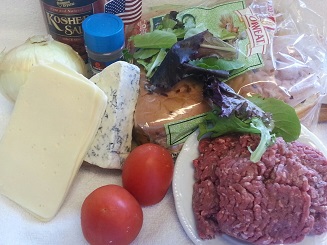
Everything for our decadent 4th of July burgers.
Remember, on the grill or the stove–160°F is the safety zone for hamburger.
Castello di Amorosa’s Zinfandel from Russian River Valley is spicy and fruity with hints of potpourri and dried Bing Cherries. Just big and bright enough for the Bleu and Cheddar.
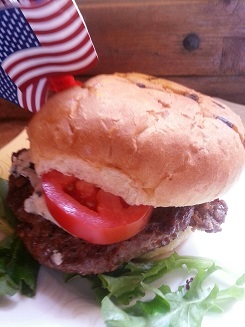
Happiness pursued and achieved–enjoy with your firework spectacular!
Corkage Fees and BYOB – Part 1

Mary Davidek
Corkage Fees and BYOB – Part 1
BYOB = Bring Your Own Bottle
Corkage Fee = the fee charged to open and serve a bottle of wine not purchased at the dining establishment
Every restaurant has restrictions and specifications which are said to cover the cost of opening a bottle, providing stemware, and serving the wine. Realistically, a corkage fee is charged to cover lost revenue. I am unabashedly a self-professed BYOB junkie; a dedicated corkage hound ……and I go to extremes in my pursuit. Here are a few situations I have encountered and simple resolutions which may help in your quest.
1. Call the restaurant or check their website prior to your reservation as fees and restrictions vary. Some restaurants may impose a 1-bottle limit and others may have more tempting ways to capture your attention. A growing trend; restaurants charge a fee but will comp it one for one, for every bottle purchased. For example, restaurant “X” charged $25 corkage. I brought in a bottle of Castello di Amorosa Cabernet Sauvignon. From the restaurant wine list I selected a bottle of Sauvignon Blanc to enjoy with apps. I love a zippy Sauvignon Blanc with bruschetta and goat cheese on a warm baguette; sublime. The bottle I purchased was $28. That’s right, the corkage fee for my Castello di Amorosa bottle was waived. This is clearly a win-win. Typically I bring in a red and purchase a white from the list as even the grandest wine menu offers a tasty and affordable white wine.
2. A common and reasonable request; the bottle you bring in cannot be available for purchase on the existing wine list. To ensure your selection for carry-in is acceptable, browse the wine list on-line or request a fax or emailed copy prior to your planned visit. Here is my fool-proof solution. Bring in wine from a winery that does not distribute. This is becoming easier as more small and mid-sized wineries are opting for direct-to –consumer sales only. Castello di Amorosa wines have been a fixture on my restaurant outings for this very reason. Restaurant wine lists change weekly and this takes the guess work out of it.
3. Prepare your bottles. If you want a chilled bottle of bubbly with your Dungeness crab; chill it. If you are bringing a Napa Cab with a little age on it, stand it up for a few hours prior to leaving which allows sediment to collect at the bottom.
4. I have seen bottles transported in everything from a paper shopping tote to a plastic grocery bag. My advice; invest in a respectable wine carrier. From leather totes to canvas carrying bags to decorative wine boxes – your wine should travel in style.
Good news for us food and wine lovers, corkage and BYOB is becoming an accepted standard. Restaurant owners are adopting more favorable corkage policies as a marketing tool.
Stay tuned……Part 2 coming up.
Cheers!
Mary Davidek C. S. , C.S.W.
Perfect Pairings Dynamic Duo

Mary Davidek
Perfect Pairings Dynamic Duo
The first time I saw the man who would eventually become my husband I was dumb-struck (quite a confession those who know me will attest). Just my type; tall, dark (it was summer), and handsome. After a chat over a glass of vino (what else?), I made the fatal mistake of telling him I thought he was smarter than I was. I say fatal mistake as it is now 24 years later and he won’t let me forget that statement.
24 years later and he won’t let me forget that statement.
Our friends often tell us they have never met 2 people more suited for each other, meant to be together. Better together as 1 than separate as 2. Like peanut butter and jelly, milk and cookies, peas and carrots……it just works.
Perfect pairings certainly enhance and intensify and one thing which is singularly good, but with food and wine, perfect pairings take on a new meaning. If you have ever been on the Royal Pairing Tour at Castello di Amorosa you may have experienced a few of these perfect pairings. A rich pate’ with Castello’s award winning Il Passito comes to mind. Sommeliers agree this match is perfection. Popular wine writer Karen Macneil says “this luxurious pairing comes perilously close to maxing out the human tolerance for pleasure”. An endorsement like that certainly piques the imagination. But, must perfect pairings always be so lofty, and quite candidly, so costly to be perfect? Does perfection have a price? A rule of thumb, pair rich with rich and humble with humble. One of my affordable favorites, a simple roast chicken (any grocery store’s rotisserie is fine), and a bottle of Pinot Noir. The rustic flavors of a simple roast chicken, a loaf of crusty bread and the earthy tones of Pinot Noir are magical together. When selecting your pinot go for light and fruity bottlings from Sonoma. For my dollar Castello’s Los Carneros Pinot Noir is the perfect choice with a hit of clove balanced with bright fruit. This Valentine’s Day, a day dedicated to perfect pairings, celebrate this dynamic duo with your honey. Light a couple of candles, put in your favorite music, pour a couple glasses of vino and relax.
Throughout the year, connect with your inner match-maker; go forth and discover new and exciting pairings.
And remember, perfection is in the eyes of the beholder……
Cheers and Happy Valentine’s Day
Mary Davidek C.S., C.S.W
